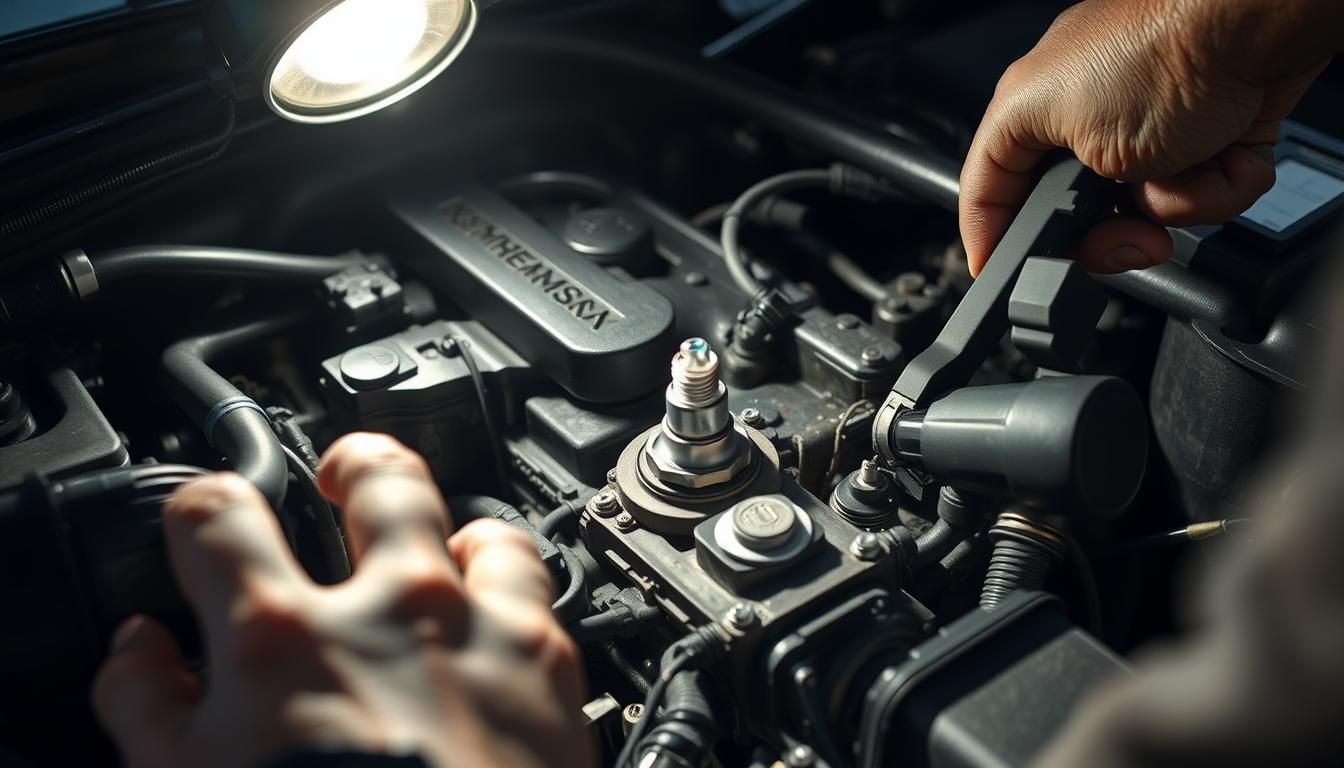That sudden shudder or hesitation from your vehicle is more than just an annoyance. It’s a signal that something is wrong under the hood. We at Heaven Automotive want to help you understand what’s happening.
This issue occurs when a cylinder in your car’s powerplant fails to fire correctly. Think of combustion as the steady heartbeat of your motor. A misfire is like a skipped beat, disrupting the perfect timing needed for smooth operation.
Ignoring these symptoms can lead to bigger, more expensive problems down the road. This guide is for everyone, whether you’re a seasoned DIYer or just starting to learn about auto maintenance.
We will walk you through the common reasons for this problem. You’ll learn about the three key ingredients for combustion: air, fuel, and spark. We’ll also cover simple checks you can do yourself and when it’s best to seek professional help.
Key Takeaways
- An engine misfire happens when a cylinder doesn’t combust fuel properly.
- This problem causes rough performance and should not be ignored.
- Understanding the root cause is key to finding the right solution.
- Combustion requires a precise balance of air, fuel, and spark.
- Some diagnostics are DIY-friendly, while others need a professional.
- Addressing a misfire promptly can prevent further damage to your car.
Understanding Engine Misfires
That jarring shake or loss of momentum you feel means one of your car’s cylinders isn’t pulling its weight. Let’s break down what’s actually happening when this occurs.
What is a Misfire and Why It Occurs
Think of your motor as a team where each cylinder has a specific job. A misfire happens when one member fails to complete its task. The normal combustion process is a perfectly timed sequence.
This critical process requires three key ingredients: air, fuel, and spark. If there’s an issue with any one of these, the mixture in the cylinder won’t ignite correctly. The timing is thrown off, causing the stumble you experience.
Recognizing the Signs and Symptoms
Your car gives you clear signals when this problem arises. The most common symptom is a rough idle, where the whole vehicle shakes when stopped.
You might also feel a significant loss of power during acceleration. Your fuel economy can drop because the motor works harder to compensate. A flashing check engine light is a specific warning that demands immediate attention.
Other signs include unusual popping sounds from the exhaust, a strong smell of gasoline, and vibrations through the steering wheel or floor.
Common Causes of Engine Misfires
When your car starts to stumble, the problem almost always falls into one of three main areas. These are the air supply, the fuel delivery, or the spark and ignition components. An imbalance in any of these systems can cause a misfire.
Air Supply Issues and Vacuum Leaks
Your vehicle’s computer needs to know exactly how much air is entering to create the perfect air-fuel mixture. Vacuum leaks from cracked hoses let in unmetered air. This disrupts the balance.
A faulty Mass Airflow (MAF) sensor provides incorrect data. A bad Oxygen (O2) sensor can also misreport exhaust oxygen levels. Both lead to a mixture that is too lean or too rich for proper combustion.
Fuel Delivery Challenges and Injector Problems
The fuel system must deliver a precise amount of gasoline. Clogged fuel injectors cannot spray a fine mist. A dirty fuel filter restricts flow. A weak fuel pump fails to maintain pressure, especially during acceleration.
These fuel delivery challenges starve the cylinder. This results in a lean condition that prevents ignition.
Spark Plug and Ignition Coil Failures
This category covers the spark itself. Over time, spark plugs wear out. The gap between their electrodes widens. They can also get coated in carbon deposits.
Ignition coils provide the high voltage needed for a strong spark. When they fail, the voltage becomes weak or inconsistent. This leads to a weak spark or no spark at all.
Engine Misfire Repair: Diagnosing Your Engine
Modern vehicles provide valuable clues through their onboard computer systems. When that warning indicator starts flashing, your car is signaling an urgent issue that needs immediate attention.
Using an OBDII Scanner to Retrieve Error Codes
A flashing check engine light specifically indicates a misfire condition. This is different from a solid light, which signals less urgent problems. To diagnose the issue, locate the trapezoid-shaped OBDII port beneath your dashboard.
Plug in your scanner and turn the key to the accessories position. The device will display alphanumeric codes that pinpoint the problem. These codes identify whether a specific cylinder is affected or if the issue is general across all cylinders.
Performing Temperature and Compression Tests
For physical verification, use an infrared temperature meter on each exhaust manifold port. The misfiring cylinder will show significantly lower temperatures than the others. This test only works when the problem is actively occurring.
Compression testing provides deeper insight into mechanical health. After removing spark plugs one at a time, screw a gauge into each hole and crank the motor. Consistent low readings across all cylinders rule out compression issues, while low readings in adjacent cylinders may indicate serious internal damage.
How to Fix Engine Misfires: A Step-by-Step Guide
Let’s move from diagnosis to action with practical steps that address the root of the problem. We’ll start with the most common culprits that affect your car’s performance.

Inspecting and Replacing Spark Plugs and Coils
Begin by safely disconnecting the plug wire. Use a spark plug socket to remove the component for examination.
Check the electrode for damage. A black or carbon-fouled end suggests your vehicle is running rich with too much fuel. If the plug is wet with gasoline or oil, this indicates more serious issues.
Measure the gap between the metal electrode and base against your manual’s specifications. A gap that’s too wide prevents proper ignition. You may need to replace worn plug wires as well.
Test your ignition coil using a multimeter. Connect it to the coil’s top two pins after disconnecting wires. Compare the resistance reading to your vehicle’s specifications.
Evaluating the Fuel System and Injector Performance
Attach a fuel pressure gauge to the test fitting at the end of the fuel rail. Compare readings at idle and specified RPMs to manufacturer specs.
Low or inconsistent pressure points to problems with the fuel filter or fuel pump. These components can starve your system of proper fuel delivery.
Check injectors using a test light connected to the battery’s negative terminal. If the light illuminates when probing each injector’s wire, power is flowing correctly.
For cost-effective maintenance, try fuel system cleaner additives before considering replacement. This often resolves injector-related issues without expensive repairs.
Addressing Specific Components for Effective Repair
Beyond the usual suspects like spark plugs, several other components can create serious performance issues. These problems often require more targeted diagnostic approaches to identify and resolve effectively.
Targeting Sensor Issues and Engine System Imbalances
Faulty sensors are common culprits for system imbalances. The Oxygen (O2) sensor monitors exhaust oxygen levels to help the computer determine the proper air-fuel mixture.
A bad O2 sensor sends incorrect data, leading to a mixture that’s either too lean or too rich. This disruption prevents proper combustion in the cylinders.
The Mass Airflow (MAF) sensor measures incoming air volume. When it malfunctions, the computer receives false information about air intake. This results in improper fuel delivery that can cause performance problems.
Correcting Problems with Electrical and Mechanical Parts
Worn piston rings fail to seal combustion chambers properly. This allows excess oil into the cylinders and reduces compression, leading to power loss and increased oil consumption.
A stretched timing chain or slipping belt throws off valve and piston synchronization. This causes the combustion process to occur at the wrong moment, creating serious issues that demand immediate attention.
A clogged catalytic converter creates backpressure that disrupts exhaust flow. This can lead to performance issues by preventing proper gas evacuation from the system.
Addressing these specific components often requires advanced diagnostic skills. Professional services typically provide the most practical solution for these complex causes.
Maintenance Tips for Preventing Future Misfires
Proactive care is your best defense against performance issues that can leave you stranded. Regular upkeep keeps your vehicle running smoothly and helps you avoid unexpected problems.
We recommend building a simple maintenance schedule that covers the key systems. This approach saves money by preventing small issues from becoming major repairs.

Regular Sensor Checks and Timely Replacements
Follow your manufacturer’s schedule for spark plug replacements. Most vehicles need new plugs every 30,000 to 100,000 miles. Using quality plugs ensures consistent performance.
Keep your fuel system clean with periodic injector cleaning. Quality fuel from reputable stations prevents deposit buildup. This maintains the proper air-fuel mixture for optimal combustion.
Have your O2 and MAF sensors checked during routine visits. These components help balance your vehicle’s system. Addressing sensor issues early prevents bigger problems.
Don’t ignore unusual sounds like knocking or sputtering. These can be early warning signs of developing issues. Prompt attention to minor symptoms prevents power loss and maintains efficiency.
Regular diagnostics can spot potential concerns before they cause complete performance issues. Combined with proper oil changes and air filter replacements, these habits extend your vehicle’s life.
Conclusion
When your transportation starts behaving erratically, it’s signaling deeper mechanical concerns that need expert evaluation. An engine misfire should never be ignored, as it can lead to decreased performance and potentially serious damage.
Remember the three main categories we discussed: air supply, fuel delivery, and ignition issues. Identifying which system is affected is crucial for effective repair. While DIY diagnostics can help pinpoint problems, many fixes require professional tools and experience.
We strongly advise against operating a vehicle with this condition. Continuing to drive can worsen the issue and lead to complete engine failure. Recognizing early warning signs allows for prompt action that prevents major repair bills.
If you’re experiencing any sign misfire symptoms, trust the experts at Heaven Automotive. Our skilled technicians have the diagnostic equipment and knowledge to get your car running smoothly again. Contact us today for reliable service you can count on.

